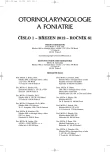What Treatment for the “Dry” Nose?
Authors:
J. Vokurka
Authors‘ workplace:
Klinika ORL, FNM
Published in:
Otorinolaryngol Foniatr, 61, 2012, No. 1, pp. 72-76.
Overview
The term “dry nose” indicates a condition, where crusts are formed in nasal cavities sometimes with a dense secrete clinging to mucosa. The mucosa may become atrophic and in some areas metaplastic, especially in the frontal parts of nasal septum. These conditions are usually treated with lavage of nasal cavities, mucosa moisturizing or treatment with ointments. It is intended to improve the trophic processes of respiration mucosa and support regeneration processes. The article contains evaluation of the preparation Rinopanteina nasal ointment, which extended the generally limited number of suitable nasal ointments.
Key words:
crusted rhinitis, dry nose, medicament rhinitis, treatment after FESS, Functional endoscopic sinus surgery, nasal ointment, “rinopanteina” nasal ointment.
Sources
1. Davidson, T. M.: Handbook of nasal disease. http://drda vidson.ucsd.edu/Portals/0/nasal.htm
2. Fokkens, W. et al.: European position paper on rhinosinusitis and nasal polyposis. Rhinology, 20 (Suppl.) 2007.
3. Jurovčík, M.: První zkušenosti s nosní mastí Rhinopanteina. Otorhinolaryng. a Foniat., s. 115-116.
4. Lawrence, E. Gibson, M. D.: Petroleum jelly: Safe for a dry nose? http://www.mayoclinic.com/health/petroleum-jelly/AN00947
5. Kehrl, W., Sonnemann, U.: Improving wound healing after nose surgery by combined administration of xylomethazoline and dexpanthenol. Laryngorhinootologie, 79, 2000, 3, s. 151-154.
6. Vokurka, J.: Kortikoidy u rinosinusitid. Alergie, 9, 2007 (Supl.) s. 37-42.
Labels
Audiology Paediatric ENT ENT (Otorhinolaryngology)Article was published in
Otorhinolaryngology and Phoniatrics

2012 Issue 1
Most read in this issue
- What Treatment for the “Dry” Nose?
- Pharyngitis Caused by Streptococcus Pyogenes
- Bleeding after Tonsillectomy and Tonsillotomy in Children
- Translabyrinth Craniotomy for Removal of Vestibular Schwannoma
